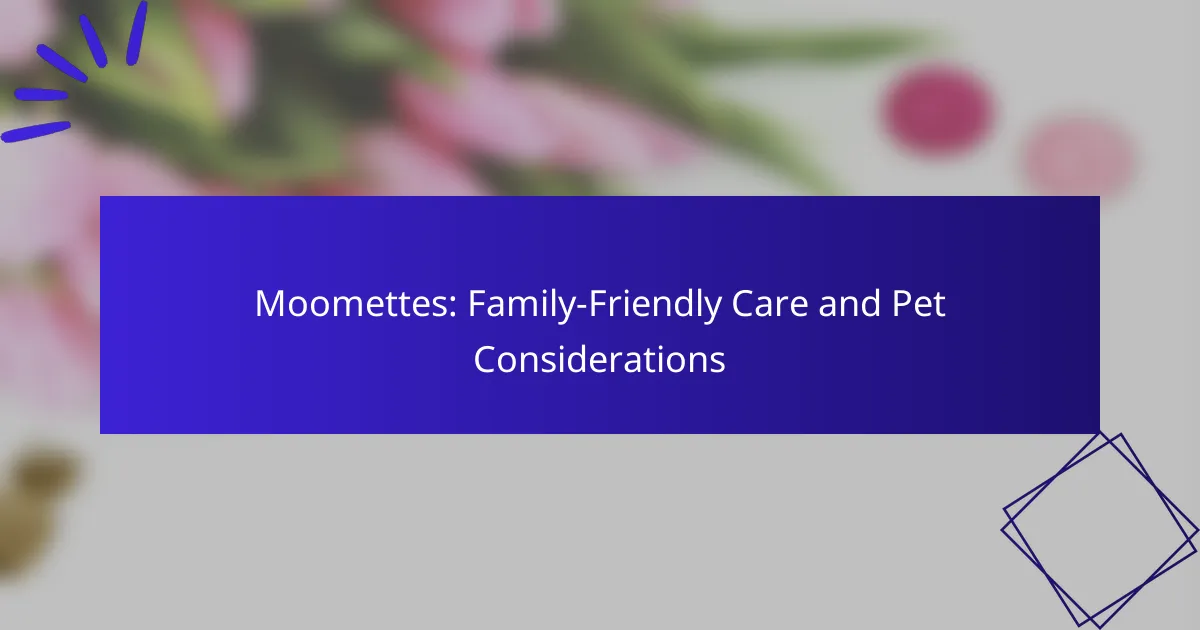Moomettes offer a range of family-friendly care options that cater to both pets and their owners, ensuring that daily routines can continue smoothly while providing the necessary attention to these beloved animals. When selecting a pet, families should consider factors like temperament and lifestyle to foster a harmonious living environment. Additionally, prioritizing health through regular veterinary visits and proper nutrition is crucial for the well-being of Moomettes.

What are family-friendly care options for Moomettes?
Family-friendly care options for Moomettes include various services designed to accommodate both pets and their families. These options ensure that Moomettes receive proper care while allowing families to maintain their daily routines and responsibilities.
In-home pet care services
In-home pet care services provide personalized attention to Moomettes in the comfort of their own environment. These services often include pet sitting, feeding, and walking, allowing pets to stay in familiar surroundings while their owners are away.
When selecting an in-home service, consider checking reviews and ensuring that the caregivers are trained in pet care. Many services offer flexible scheduling, which can be beneficial for families with varying needs.
Pet-friendly daycare facilities
Pet-friendly daycare facilities offer a safe and engaging environment for Moomettes during the day. These facilities typically provide socialization opportunities with other pets, supervised playtime, and structured activities to keep pets active and entertained.
When choosing a daycare, look for facilities that maintain high standards of cleanliness and safety. It’s advisable to visit the facility beforehand to observe the environment and meet the staff.
Family-oriented pet training programs
Family-oriented pet training programs focus on teaching Moomettes essential skills while involving the entire family in the training process. These programs often emphasize positive reinforcement techniques and can help strengthen the bond between pets and their owners.
Consider enrolling in classes that cater to different skill levels and age groups. Look for programs that offer flexible schedules and group sessions, which can make training more enjoyable for both pets and families.

How to choose the right pet for families?
Choosing the right pet for families involves considering various factors such as temperament, lifestyle, and space requirements. A well-matched pet can enhance family life, providing companionship and joy while minimizing potential challenges.
Consider breed temperament
Different breeds exhibit varying temperaments, which can significantly affect family dynamics. For instance, breeds like Labrador Retrievers and Golden Retrievers are known for their friendly and gentle nature, making them great choices for families with children.
On the other hand, some breeds may be more reserved or require specific training to interact well with kids. Researching breed characteristics and seeking advice from breeders or shelters can help ensure a good fit.
Assess family lifestyle compatibility
Understanding your family’s lifestyle is crucial when selecting a pet. Active families may benefit from high-energy dogs that enjoy outdoor activities, while those with a more relaxed lifestyle might prefer lower-energy pets, such as cats or smaller dog breeds.
Consider daily routines, work schedules, and the amount of time available for pet care. A pet that aligns with your family’s lifestyle will be happier and better integrated into your home.
Evaluate pet size and space needs
The size of the pet and the available living space are important factors to consider. Larger breeds typically require more room to move and play, while smaller pets can adapt to smaller living environments, such as apartments.
Additionally, ensure that your home has a safe area for the pet to exercise and explore. If you have a yard, consider how it can accommodate the pet’s needs, including fencing and space for activities.

What are the health considerations for Moomettes?
Moomettes require specific health considerations to ensure their well-being. Regular veterinary care, appropriate vaccinations, and a balanced diet are essential for maintaining their health and preventing common ailments.
Regular veterinary check-ups
Regular veterinary check-ups are crucial for Moomettes to monitor their overall health and catch any potential issues early. These visits typically occur at least once a year, but more frequent visits may be necessary for older or ill animals.
During a check-up, the veterinarian will assess the Moomette’s weight, dental health, and general condition. They may also recommend tests to screen for common diseases or parasites, ensuring that your pet remains healthy.
Vaccination schedules
Vaccination schedules for Moomettes should be established with a veterinarian to protect against various infectious diseases. Core vaccinations typically include those for rabies, distemper, and parvovirus, while non-core vaccines may be recommended based on lifestyle and exposure risks.
Initial vaccinations usually begin when the Moomette is a young kitten, followed by booster shots at specific intervals. Keeping up with these vaccinations is essential to prevent outbreaks of preventable diseases.
Nutrition and dietary needs
Nutrition and dietary needs for Moomettes are vital for their growth and health. A balanced diet should include high-quality cat food that meets their specific life stage requirements, whether they are kittens, adults, or seniors.
It’s important to monitor portion sizes and avoid overfeeding, as obesity can lead to serious health issues. Consulting with a veterinarian can help determine the best diet plan tailored to your Moomette’s individual needs, including any special dietary restrictions or preferences.

What are the best pet products for families?
The best pet products for families prioritize safety, durability, and fun for both children and pets. Selecting items that withstand rough play and are non-toxic ensures a harmonious environment for everyone.
Durable toys for children and pets
Durable toys are essential for families with pets, as they can withstand the enthusiastic play of both kids and animals. Look for toys made from tough materials like rubber or reinforced fabric that can endure chewing and rough handling.
Examples include chew-resistant balls, tug ropes, and interactive puzzle toys that engage both pets and children. Always check for safety certifications to ensure the toys are free from harmful substances.
Safe grooming supplies
Safe grooming supplies are crucial for maintaining your pet’s hygiene while ensuring the safety of your children. Choose grooming tools designed with non-slip grips and rounded edges to prevent accidents during use.
Consider using pet shampoos that are hypoallergenic and free from harsh chemicals. Regular grooming not only keeps your pet clean but also provides an opportunity for bonding between children and pets.
Pet-proofing home essentials
Pet-proofing your home is vital for creating a safe environment for both pets and children. Start by securing hazardous items like cleaning supplies and medications in high cabinets or locked drawers.
Use baby gates to restrict access to certain areas and consider corner protectors for sharp furniture edges. Additionally, ensure that any cords or small objects are out of reach to prevent choking hazards.

What are the benefits of pet ownership for families?
Pet ownership offers numerous advantages for families, including emotional support, opportunities for teaching responsibility, and encouragement of outdoor activities. These benefits contribute to a nurturing environment that fosters strong family bonds and healthy lifestyles.
Emotional support and companionship
Pets provide invaluable emotional support and companionship, helping to reduce stress and anxiety among family members. The presence of a pet can create a sense of security and comfort, especially for children who may face challenges in their daily lives.
Additionally, pets can enhance social interactions within the family and with others, as they often serve as a common interest that brings people together. This companionship can lead to improved mental health and overall well-being for everyone in the household.
Teaching responsibility to children
Owning a pet teaches children important life skills, such as responsibility and empathy. By participating in daily care routines like feeding, grooming, and walking, children learn the significance of commitment and the impact of their actions on another living being.
Parents can create age-appropriate tasks for their children, ensuring that the responsibilities grow with them. This gradual increase in responsibility can help children develop a sense of achievement and pride in caring for their pet.
Encouraging outdoor activities
Pets, especially dogs, encourage families to engage in outdoor activities together, promoting a more active lifestyle. Regular walks, playtime in the park, and outdoor adventures can significantly increase physical activity levels for both pets and their owners.
Families can explore local parks or nature trails, making outdoor time enjoyable and beneficial for everyone. This shared experience not only enhances physical health but also strengthens family bonds through quality time spent together in nature.
